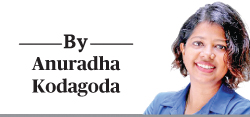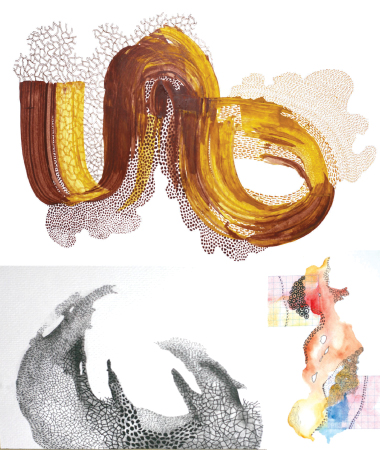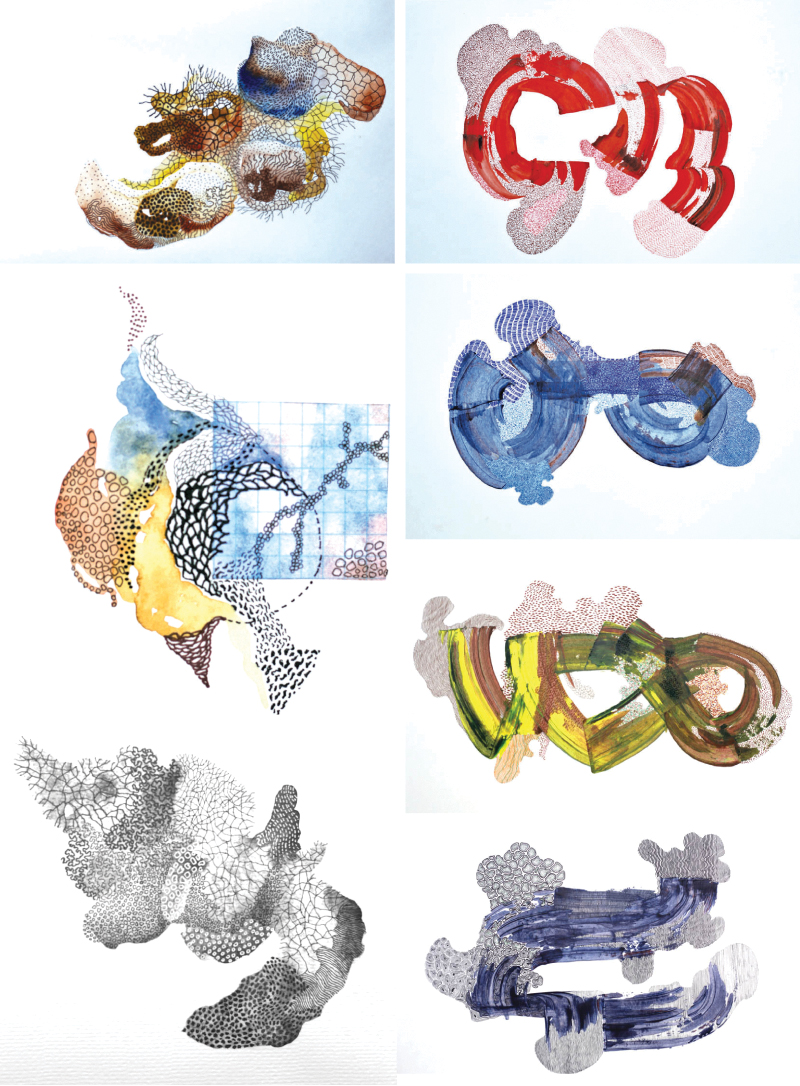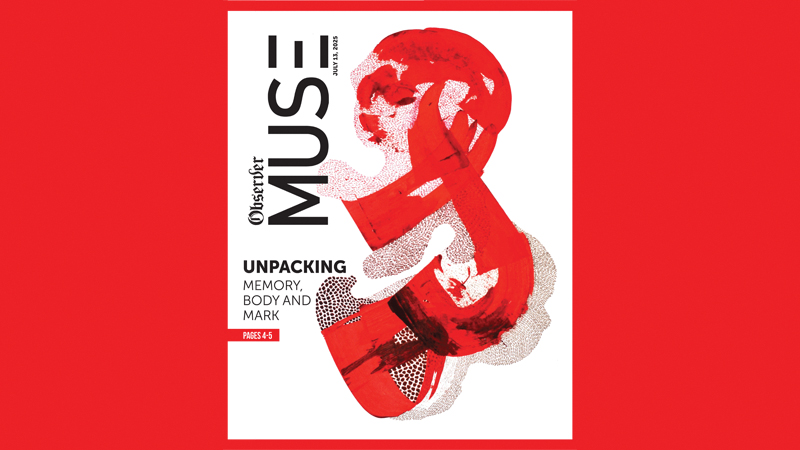 Step into the world of visual artist Thabendran Krishnapriya through her latest exhibition ‘Mindscapes’ now displayed at the Barefoot Gallery.
Step into the world of visual artist Thabendran Krishnapriya through her latest exhibition ‘Mindscapes’ now displayed at the Barefoot Gallery.
Through her latest collection she turns unseen emotions into tangible art. In this candid chat, we talked about her fascinating practice behind the ‘Mindscape’ and explored how everyday marks become profound expressions, the surprising stories hidden in every texture and line. It’s a journey where the body speaks, memory takes shape, and even a humble brush stroke holds a universe of meaning. Let’s peel back the layers and get to know the mind and hand behind these powerful works.
Q: Micro lens cells are the primary shape you use in your artworks. Can you speak about the artistic decision you have made in choosing this as your primary shape?
A: The micro-lens cell is more than just a visual motif in my work, it is a conceptual and emotional vessel. I’m drawn to this form because it holds both scientific clarity and poetic ambiguity. It reminds me of the foundational units of life, yet it also resembles petals, scars, or openings, shapes that resonate deeply with the language of memory and the body.
 Choosing this shape is my way of referencing the microscopic scale of experience, the tiny, often invisible emotional and cultural imprints that form who we are. These cells become containers of memory, places where stories settle, dissolve, or re-emerge.
Choosing this shape is my way of referencing the microscopic scale of experience, the tiny, often invisible emotional and cultural imprints that form who we are. These cells become containers of memory, places where stories settle, dissolve, or re-emerge.
They’re abstract enough to remain open, but specific enough to feel anatomical, floral, or tactile. The repeated use of micro-lens forms also mimics the act of looking through, of focusing in and out, of observation as a bodily and emotional process. They act like memory portals, fragile, layered, and luminous. In that sense, they aren’t just shapes; they’re thresholds between inner and outer worlds.
Q: Compared to your previous series there’s a new noticeable brush stroke. What is the artistic intention and the story behind that brush stroke?
A: The brush stroke in this series represents a fundamental truth about memory: it cannot simply be erased. The more we try to wipe it away, the more it spreads, like ink on damp paper, or emotion resurfacing when least expected. This gesture emerged from my realization that attempts to silence or suppress memory often leads to deeper entanglement.
Unlike the controlled, embossed marks in my earlier works, the brush stroke brings in an element of resistance and consequence. It is a response to the weight of trauma, to inherited stories, to the messy and persistent nature of recollection.
The spreading brushwork acts almost like a stain, something that cannot be undone, only acknowledged and integrated. By using this form, I wanted to show that memory isn’t passive. It reacts. It transforms. And in that transformation, something new is revealed, something honest, unresolved, and necessary.
Q: Can you explain about the materials you use for your drawings, and why?
A: The materials I use, embossing tools, nails, tracing paper, graphite, ink, and soft pigments, are chosen for their sensitivity, their physicality, and their ability to hold memory through mark and surface. I’m drawn to mediums that allow me to work through touch, pressure, and repetition.
The act of drawing is not just about making an image, it’s about inscribing emotion, carving presence, and holding silence. Embossing is central to my practice. I use it to create forms that are not simply drawn, but pressed into being. It’s a slow and meditative process, one that echoes the persistence of memory and the imprint of lived experience.
The use of nails and pointed tools references both fragility and resilience, these are materials that puncture, that scar, that leave behind subtle yet permanent marks. I often choose lightweight, translucent surfaces like tracing paper because they embody the ephemeral and layered nature of memory.
These surfaces allow the drawing to exist in states of both presence and absence, what is visible and what is just beneath. The graphite and ink serve as both line and residue, offering control and unpredictability at the same time.
Ultimately, I use materials that respond to the body, its weight, its breath, its tremors, and that hold the kind of intimate language I want to speak. My process is tactile, physical, and emotionally charged. Every material I choose carries meaning: pressure becomes presence, line becomes voice, and surface becomes a vessel for remembering.
Q: You mentioned “thought, memory, and physicality converge” in your marks. Can you give an example of how a specific memory or feeling might lead to a particular type of mark on your drawing?
A: When I make a mark, it often begins with a sensation, an emotional residue rather than a clear image. For example, the memory of being in my father’s printing studio as a child, the smell of ink, the repetition of mechanical sounds, the texture of worn paper, stirs a need for slow, rhythmic embossing.
I might press a tool into the paper repeatedly in a structured grid, mimicking the cadence of the press, allowing that memory to manifest physically through form and pressure. Other times, the feeling of loss or emotional weight might guide my hand into looser, heavier gestures, dragged lines, smeared graphite, or spreading ink, reflecting a sense of uncontrollable memory, something that refuses to stay contained.
A brush stroke might sweep across the page like a wave of grief, or a fine, repetitive puncture could mirror the quiet persistence of an unresolved thought. Each mark becomes a trace of thought, memory, and the body’s movement in response. It’s never just about creating an image, it’s about translating an inner state into surface, allowing the drawing to hold what words cannot.
Q: Your work uses sacred shapes like the “Eight Square grid.” How do these geometric shapes help you start or build your drawings? Do you draw them first?
A: Yes, sacred shapes like the Eight Square Grid, the Egg of Life, or the Golden Ratio are quiet foundations in many of my drawings. These geometric forms hold symbolic meaning across cultures, connected to creation, balance, and the interconnectedness of life. For me, they are not just compositional tools, but spiritual structures that guide the flow of my work.
I often begin by lightly sketching these grids or circles, not to define the final image, but to establish a rhythm. They offer a framework, an underlying architecture that holds the more intuitive, emotional gestures I layer on top. Think of them like a skeleton or heartbeat beneath the skin of the drawing.
Sometimes the geometry remains visible, sometimes it disappears beneath the marks, becoming part of the memory of the surface. Either way, it’s always there, an invisible order beneath the seeming chaos. These shapes help me explore how the body, nature, and memory are all part of a larger, repeating pattern, something sacred and continuous.
The Eight Square Grid, in particular, allows me to anchor memory within structure, offering both stability and openness. It’s a quiet ritual to draw it, and that act of repetition becomes a meditative beginning, a way to invite clarity and intention into each piece.
Q: When you call drawing a “ritual of mapping,” what do you mean? Is it a calm process for you?
A: When I call drawing a “ritual of mapping,” I mean that it’s both a spiritual and physical process, a way of locating memory, emotion, and presence through the body. Each mark I make is like tracing an internal landscape, not a literal one, but one shaped by experience, trauma, ancestry, and healing.
It’s ritualistic in that I often repeat the same gestures, embossing, pressing, drawing, layering, almost like chanting or breathing. These repetitions ground me, giving the process a meditative rhythm. So yes, it can be calming, but not always in a soft or peaceful way. Sometimes it’s intense, especially when I’m working through difficult memories or emotional weight.
But even then, it’s a form of release. Drawing becomes a ritual not because it’s always calm, but because it’s intentional. It’s where I come to make sense of what the body holds, what it remembers. Through drawing, I map the unseen, those quiet, often forgotten spaces within myself. And in that mapping, I find connection, clarity, and sometimes healing.







